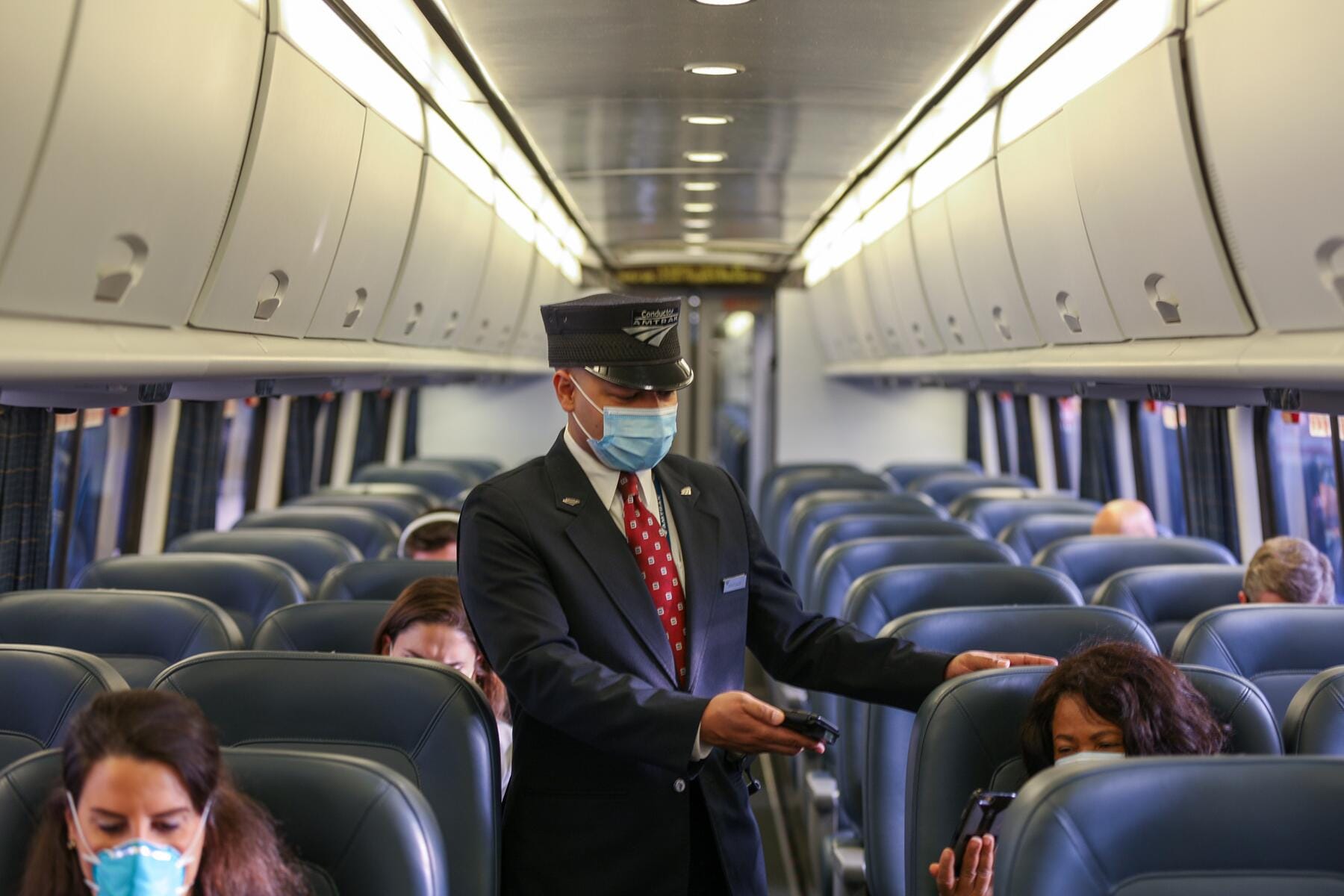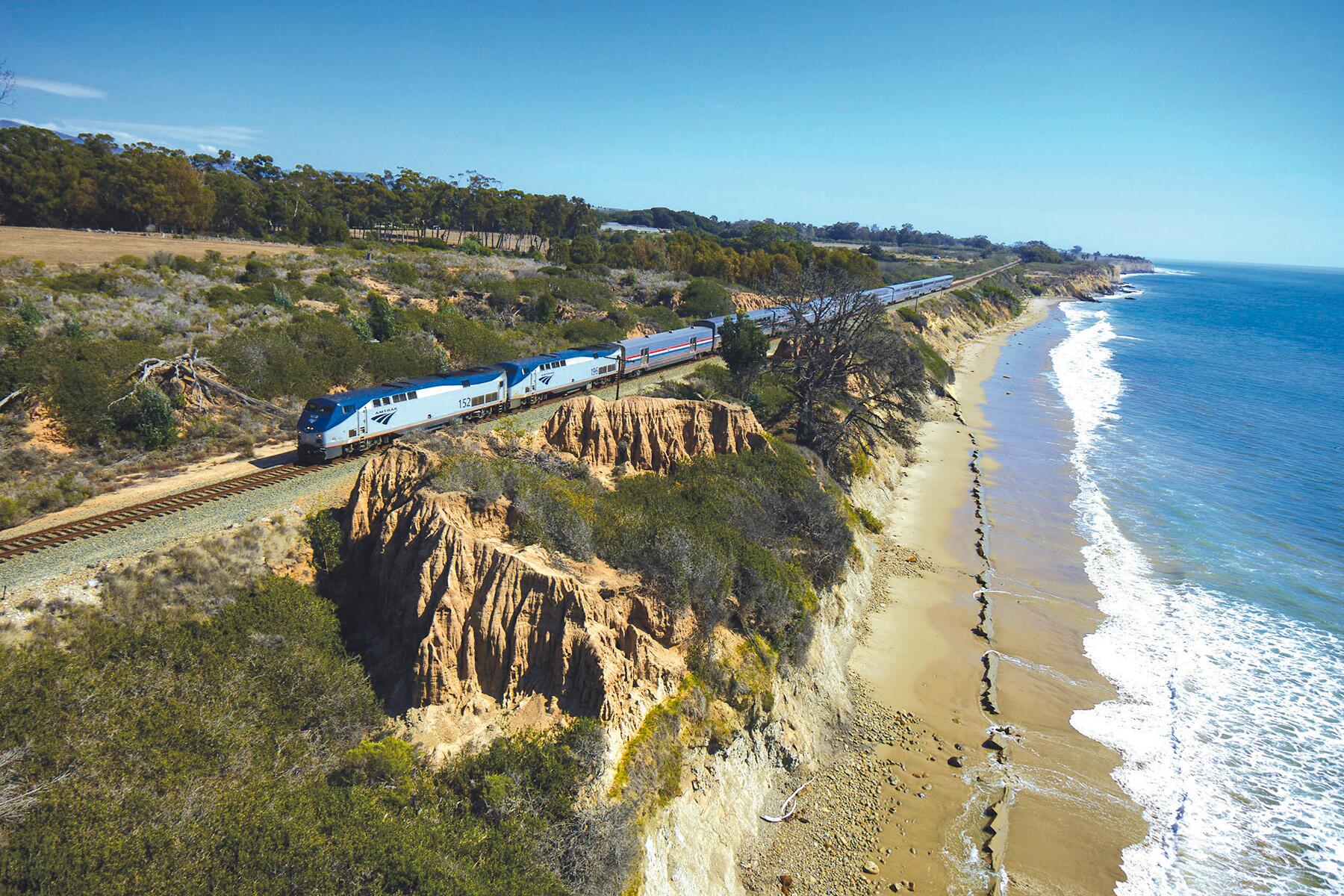While precautions must be taken, train travel can be considered relatively safe.
Train travel is often romanticized—hearkening back to less-complicated times, it offers the traveler a bird’s eye view of the passing scenery at a slower pace. Staring out the window as the landscape evolves, this always has the inevitable effect of bringing me into the moment, as the leisurely motion of the train lulls me into a state of relaxed awareness.
So when I had the opportunity to visit Santa Barbara recently, I decided to make the trip via Amtrak’s Pacific Surfliner. But before doing that I wanted to make sure that I traveled responsibly, which meant asking questions about the safety of trains during this time as well as how to best protect myself. I reached out to a representative from Amtrak, and also spoke with a medical doctor, who both provided valuable perspectives.
How Safe Is Train Travel?
According to Dr. Gregg DeNicola, the chief medical officer at Caduceus Medical Group, “If you look at five modes of transportation—boats, planes, buses, trains, or private cars, I believe that private cars are the safest. Trains would be the next safest.”
The on-boarding process is one example of why trains can be considered safer. As opposed to boarding a plane where you are indoors and often around a lot of people, this is not as much the case with trains. As Dr. DeNicola suggests, “A train is much safer because you’re outdoors, there’s ventilation, and you can easily stand 10 to 20 feet away from people if you wanted to.” Trains are also at each station for a couple of minutes, which allows plenty of time for people to board.
Recommended Fodor’s Video
During my four-hour trip from Orange County, I felt safe while boarding because people seemed to respect each other’s physical space. Also, there were very few people in my compartment, which provided a sense of security. I was able to put my bag on the seat next to me, ensuring that I would be the only person in my row. Of course, this won’t always be the case for everyone, as it depends on when and where you are traveling.
INSIDER TIPFor the most updated information on whether it is safe to travel right now, consult “Should You Change Your Travel Plans Due to the Coronavirus?”
What Kinds of Measures Has Amtrak Taken to Adjust to COVID-19?
Roger Harris, Executive Vice President and Chief Marketing and Revenue Officer at Amtrak, states that “several cleaning, contact-free, and convenience measures have been implemented into every part of the customer journey—from the time of booking to the moment of arrival.” Some of these enhanced measures include onboard filtration systems as well as a capacity indicator next to each train that shows the number of seats that have been sold, allowing travelers to select the least crowded option. Amtrak also requires that all passengers and employees wear a face mask or covering while onboard and in stations.

Also, if your budget allows and it makes sense, many routes have private rooms available. Ranging from a roomette to three sizes of bedrooms, each private space offers access to a private restroom and shower and your own dedicated attendant.
What Is the Policy Regarding Eating and Drinking on Trains?
While it is a good idea to bring your own food on the train if possible, Amtrak has made some adjustments to their service to promote safety among passengers, which includes plastic barriers and markers to promote physical distancing. Cafe cars are currently offering carryout service only, but passengers who have booked a private room have additional options. According to Harris, “They can also enjoy the luxury of complimentary room service, which allows them to eat their meal in the comfort of their own space.”
However, Dr. DeNicola points out that eating and drinking is the only time that you should remove your mask while onboard unless you’re in a private room. “And there’s nothing to say that when you’re eating you’re immune, so obviously eat quickly,” he says.
What Are the Best Ways to Protect Yourself?
There are a few things that you can do to protect yourself, most importantly wearing a mask. Also, carry hand sanitizer with you and use it frequently during your trip, especially after visiting the cafe car or the restroom. Select your seat carefully—if you don’t already have a reserved seat—by aiming to find a spot in the least-populated area of the car, and maintain as much physical distance from others as possible.
The three most important factors are wearing a mask, the number of people around you, and how long you’re going to be with them. “You want to use that to your advantage—wear the mask, take the shortest trip you can get away with, and try to stay as far away as you can from people,” Dr. DeNicola suggests. Also, be sure to bring antibacterial wipes with you to clean common surfaces like tray tables and hand railings.
INSIDER TIPDownload the Amtrak app, which makes contactless travel a breeze. You can use the app to book, board, check train status and capacity, and access information regarding delays.
What About Other Passengers Who Refuse to Wear Masks or Adhere to Safety Guidelines?
During my trip, I did notice that some passengers weren’t in a hurry to put their masks back on after eating. This is what concerned me the most, so I inquired about the policy regarding those who refuse to comply.
According to Harris, “Amtrak reserves the right to remove a customer or ban them from future travel in the event of non-compliance with Amtrak’s face covering policy.” If you notice someone who has violated this policy, rather than approaching the person yourself, Amtrak suggests notifying an employee, who will address the situation.
Should You Self-Quarantine After Traveling on a Long-Haul Route?
The short answer: It all depends on where your destination originates and ends. According to Harris, “We encourage all customers to familiarize themselves with and adhere to the health and safety protocols of their destination before booking.” If you’re coming from a high-risk state, you may be required to provide a negative COVID test or to self-quarantine. Visit The Status of Each State for information about travel restrictions and what is currently open and closed.

Dr. DeNicola emphasizes that you shouldn’t travel if you are experiencing symptoms or if you’ve been exposed to someone who has tested positive for COVID within the last 14 days. He also suggests taking a COVID test before traveling, just for peace of mind. “If it is a long train trip, like across the country, I think it would be critical to be tested,” he says.
INSIDER TIPAmtrak is waiving all change fees for reservations made by December 31 and all cancelation fees by October 31, which includes reservations booked with points. This allows for a bit more flexibility with your travel plans.
What Are Some Popular Amtrak Routes to Explore?
While I’m personally biased towards the Pacific Surfliner line which travels up and down the coast from San Diego to San Luis Obispo, there are so many other routes that are perfect for fall and winter. If you’re a die-hard fall foliage fan you will love the Capitol Limited line, which runs from Washington, D.C. to Chicago. The Vermonter line, which travels through New England, is another famous destination for leaf-peeping.
As the leaves fall from the trees and winter approaches, take a trip through the Rockies and Sierras on the California Zephyr, which also travels through Utah’s Red Rock Country. Or, take the Empire Builder, which journeys more than 2,200 miles from Chicago to either Seattle or Portland.




Planes are the safest way to travel right now. Driving is the most dangerous. I would rank planes first, trains second. Many studies show that the risk of catching COVID-19 from air travel is very low.